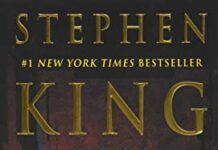
Ebook Info
- Published: 2014
- Number of pages: 336 pages
- Format: Epub
- File Size: 188.93 MB
- Authors: George R. R. Martin
Description
NEW YORK TIMES BESTSELLER • Perfect for fans of A Song of Ice and Fire and HBO’s Game of Thrones—an epic history of Westeros and the lands beyond, featuring hundreds of pages of all-new material from George R. R. Martin!
If the past is prologue, then George R. R. Martin’s masterwork—the most inventive and entertaining fantasy saga of our time—warrants one hell of an introduction. At long last, it has arrived with The World of Ice & Fire.
This lavishly illustrated volume is a comprehensive history of the Seven Kingdoms, providing vividly constructed accounts of the epic battles, bitter rivalries, and daring rebellions that lead to the events of A Song of Ice and Fire and HBO’s Game of Thrones. In a collaboration that’s been years in the making, Martin has teamed with Elio M. García, Jr., and Linda Antonsson, the founders of the renowned fan site Westeros.org—perhaps the only people who know this world almost as well as its visionary creator.
Collected here is all the accumulated knowledge, scholarly speculation, and inherited folk tales of maesters and septons, maegi and singers, including
• full-color artwork and maps, with more than 170 original pieces
• full family trees for Houses Stark, Lannister, and Targaryen
• in-depth explorations of the history and culture of Westeros
• 100% all-new material, more than half of which Martin wrote specifically for this book
The definitive companion piece to George R. R. Martin’s dazzlingly conceived universe, The World of Ice & Fire is indeed proof that the pen is mightier than a storm of swords.
User’s Reviews
George R. R. Martin is the #1 New York Times bestselling author of many novels, including the acclaimed series A Song of Ice and Fire—A Game of Thrones, A Clash of Kings, A Storm of Swords, A Feast for Crows, and A Dance with Dragons—as well as Tuf Voyaging, Fevre Dream, The Armageddon Rag, Dying of the Light, Windhaven (with Lisa Tuttle), and Dreamsongs Volumes I and II. He is also the creator of The Lands of Ice and Fire, a collection of maps from A Song of Ice and Fire featuring original artwork from illustrator and cartographer Jonathan Roberts. As a writer-producer, Martin has worked on The Twilight Zone, Beauty and the Beast, and various feature films and pilots that were never made. He lives with the lovely Parris in Santa Fe, New Mexico. Elio M. García, Jr., and Linda Antonsson founded and run the popular Westeros fansite, which is the definitive source for all things George R. R. Martin. Excerpt. © Reprinted by permission. All rights reserved. THE DAWN AGE THERE ARE NONE who can say with certain knowledge when the world began, yet this has not stopped many maesters and learned men from seeking the answer. Is it forty thousand years old, as some hold, or perhaps a number as large as five hundred thousand—or even more? It is not written in any book that we know, for in the first age of the world, the Dawn Age, men were not lettered. We can be certain that the world was far more primitive, however—a barbarous place of tribes living directly from the land with no knowledge of the working of metal or the taming of beasts. What little is known to us of those days is contained in the oldest of texts: the tales written down by the Andals, by the Valyrians, and by the Ghiscari, and even by those distant people of fabled Asshai. Yet however ancient those lettered races, they were not even children during the Dawn Age. So what truths their tales contain are difficult to find, like seeds among chaff. What can most accurately be told about the Dawn Age? The eastern lands were awash with many peoples—uncivilized, as all the world was uncivilized, but numerous. But on Westeros, from the Lands of Always Winter to the shores of the Summer Sea, only two peoples existed: the children of the forest and the race of creatures known as the giants. Of the giants in the Dawn Age, little and less can be said, for no one has gathered their tales, their legends, their histories. Men of the Watch say the wildlings have tales of the giants living uneasily alongside the children, ranging where they would and taking what they wanted. All the accounts claim that they were huge and powerful creatures, but simple. Reliable accounts from the rangers of the Night’s Watch, who were the last men to see the giants while they still lived, state that they were covered in a thick fur rather than simply being very large men as the nursery tales hold. There is considerable evidence of burials among the giants, as recorded in Maester Kennet’s Passages of the Dead—a study of the barrow fields and graves and tombs of the North in his time of service at Winterfell, during the long reign of Cregan Stark. From bones that have been found in the North and sent to the Citadel, some maesters estimate that the largest of the giants could reach fourteen feet, though others say twelve feet is nearer the truth. The tales of long-dead rangers written down by maesters of the Watch all agree that the giants did not make homes or garments, and knew of no better tools or weapons than branches pulled from trees. The giants had no kings and no lords, made no homes save in caverns or beneath tall trees, and they worked neither metal nor fields. They remained creatures of the Dawn Age even as the ages passed them by, men grew ever more numerous, and the forests were tamed and dwindled. Now the giants are gone even in the lands beyond the Wall, and the last reports of them are more than a hundred years old. And even those are dubious—tales that rangers of the Watch might tell over a warm fire. The children of the forest were, in many ways, the opposites of the giants. As small as children but dark and beautiful, they lived in a manner we might call crude today, yet they were still less barbarous than the giants. They worked no metal, but they had great art in working obsidian (what the smallfolk call dragonglass, while the Valyrians knew it by a word meaning “frozen fire”) to make tools and weapons for hunting. They wove no cloths but were skilled in making garments of leaves and bark. They learned to make bows of weirwood and to construct flying snares of grass, and both of the sexes hunted with these. Their song and music was said to be as beautiful as they were, but what they sang of is not remembered save in small fragments handed down from ancient days. Maester Childer’s Winter’s Kings, or the Legends and Lineages of the Starks of Winterfell contains a part of a ballad alleged to tell of the time Brandon the Builder sought the aid of the children while raising the Wall. He was taken to a secret place to meet with them, but could not at first understand their speech, which was described as sounding like the song of stones in a brook, or the wind through leaves, or the rain upon the water. The manner in which Brandon learned to comprehend the speech of the children is a tale in itself, and not worth repeating here. But it seems clear that their speech originated, or drew inspiration from, the sounds they heard every day. The gods the children worshipped were the nameless ones that would one day become the gods of the First Men—the innumerable gods of the streams and forests and stones. It was the children who carved the weirwoods with faces, perhaps to give eyes to their gods so that they might watch their worshippers at their devotions. Others, with little evidence, claim that the greenseers—the wise men of the children—were able to see through the eyes of the carved weirwoods. The supposed proof is the fact that the First Men themselves believed this; it was their fear of the weirwoods spying upon them that drove them to cut down many of the carved trees and weirwood groves, to deny the children such an advantage. Yet the First Men were less learned than we are now, and credited things that their descendants today do not; consider Maester Yorrick’s Wed to the Sea, Being an Account of the History of White Harbor from Its Earliest Days, which recounts the practice of blood sacrifice to the old gods. Such sacrifices persisted as recently as five centuries ago, according to accounts from Maester Yorrick’s predecessors at White Harbor. This is not to say that the greenseers did not know lost arts that belong to the higher mysteries, such as seeing events at a great distance or communicating across half a realm (as the Valyrians, who came long after them, did). But mayhaps some of the feats of the greenseers have more to do with foolish tales than truth. They could not change their forms into those of beasts, as some would have it, but it seems true that they were capable of communicating with animals in a way that we cannot now achieve; it is from this that legends of skinchangers, or beastlings, arose. In truth, the legends of the skinchangers are many, but the most common—brought from beyond the Wall by men of the Night’s Watch, and recorded at the Wall by septons and maesters of centuries past—hold that the skinchangers not only communicated with beasts, but could control them by having their spirits mingle. Even among the wildlings, these skinchangers were feared as unnatural men who could call on animals as allies. Some tales speak of skinchangers losing themselves in their beasts, and others say that the animals could speak with a human voice when a skinchanger controlled them. But all the tales agree that the most common skinchangers were men who controlled wolves—even direwolves—and these had a special name among the wildlings: wargs. Legend further holds that the greenseers could also delve into the past and see far into the future. But as all our learning has shown us, the higher mysteries that claim this power also claim that their visions of the things to come are unclear and often misleading—a useful thing to say when seeking to fool the unwary with fortune-telling. Though the children had arts of their own, the truth must always be separated from superstition, and knowledge must be tested and made sure. The higher mysteries, the arts of magic, were and are beyond the boundaries of our mortal ability to examine. Yet no matter the truths of their arts, the children were led by their greenseers, and there is no doubt that they could once be found from the Lands of Always Winter to the shores of the Summer Sea. They made their homes simply, constructing no holdfasts or castles or cities. Instead they resided in the woods, in crannogs, in bogs and marshes, and even in caverns and hollow hills. It is said that, in the woods, they made shelters of leaves and withes up in the branches of trees—secret tree “towns.” It has long been held that they did this for protection from predators such as direwolves or shadowcats, which their simple stone weapons—and even their vaunted greenseers—were not proof against. But other sources dispute this, stating that their greatest foes were the giants, as hinted at in tales told in the North, and as possibly proved by Maester Kennet in the study of a barrow near the Long Lake—a giant’s burial with obsidian arrowheads found amidst the extant ribs. It brings to mind a transcription of a wildling song in Maester Herryk’s History of the Kings-Beyond-the-Wall, regarding the brothers Gendel and Gorne. They were called upon to mediate a dispute between a clan of children and a family of giants over the possession of a cavern. Gendel and Gorne, it is said, ultimately resolved the matter through trickery, making both sides disavow any desire for the cavern, after the brothers discovered it was a part of a greater chain of caverns that eventually passed beneath the Wall. But considering that the wildlings have no letters, their traditions must be looked at with a jaundiced eye.
Reviews from Amazon users, collected at the time the book is getting published on UniedVRG. It can be related to shiping or paper quality instead of the book content:
⭐ This is not a story book; it’s a history book and it’s written as such. The idea is that Maester Yandel wrote this book as a gift to the king. (The Baratheons get treated quite favorably in this tome; this is a Maester who is trying to get somewhere.)The rest is—well, if you (like me) enjoy history or are a hard-core R. R. Martin fan you will like this book. If not, you may not—though you will love the beautiful illustrations, the embossed dragons on the front cover and the parchment-like background designs. And you will love the way this book feels. It’s wonderfully constructed. The covers are padded and the pages are sewn to the book’s spine. And the pages themselves are not the cheap-feeling pages you normally get; they’re thick and slightly glossy. So the illustrations and the construction are superb.The text is—history book like. I learned a lot. I discovered that there are dragons just about everywhere, what Valyrians call dragon glass, what the Dorne has against the iron Throne, how greyscale came into the world, some pretty horrific stories about the Others, and much more besides. I was particularly interested in the legends the Maester mentions again and again only to dismiss them as a learned man is taught to do. Anyone who has either read R. R. Martin’s novels will know that these fanciful stories are, in fact, all too true.And let’s face it, we have a year and half to speculate about how the Game of Thrones will end. I can’t claim to know the ending but, if the writers are at all true to the books, the ending will be rooted in the history of Westeros. And this book–while written in the often dry tone I for one often associate with history books—most definitely provides that history.So if you need some help speculating about what (say) an ice dragon might do (and yes, ice dragons do put in an appearance here), you might want to check out the Untold History of Westeros.
⭐ This is a gorgeous, heavy and over-sized book. The artwork is awesome and it has maps and genealogical tables of the more prominent families. Definitely recommended for the game of throne enthusiast.
⭐ Very interesting. For those who don’t know, this is pretty much a history book of Westeros and what is known of Essos and Sothoryos. It was written by a maester for King Robert Baratheon, and you’ll notice the language becomes very flowery when his reign is mentioned. Some topics mentioned did not make it into the TV show until at least a year or two after the book was published. It offers a detailed account of events of the past deeds of Tywin Lannister, and you kinda see why he was like he was. The front and back covers are padded and feel very high-quality. The artwork all throughout this book is nothing short of amazing. It’s worth the price just for that if you don’t feel like reading it. There are pictures on almost every page, but it may still take awhile to read due to small type and double-column format. Also included is a Targaryen family tree, which is more complicated and has more branches than you would expect. It becomes very hard to keep up with the ones of that family who are mentioned in the historical narrative because SO MANY of the Targaryens have the same names. For those of us who have yet to read the Game of Thrones books, this one is a great read. Very informative and well worth your time.
⭐ I won’t waste time trying to add to the many 4-Star & 5-Star reviews already posted since the have pretty much covered it all. I will say this is a striking object, with a plush, leathery cover that I don’t find on many modern books. The paper quality is first class and the illustrations are magnificent. If I wrote a book I would show my publisher this book and say, “I want my book to have the high-quality feel of this cover and the paper”. Definitely something best appreciated by the serious ASOIAF fan. It’s not a novel written from the first person perspective like the series. It’s a history book that’s supposed to be written by a Maester living after the events of Roberts Rebellion. It starts in the ancient world of the Dawn Age, covers the Children of the Forest, the migration of the First Men to Westeros, the arrival of the Andals, the Doom of Valyria, and a lot more. You get some good information on the uniting of the 7 Kingdoms by Aegon I “The Conquerer” and his sister queens Visenya and Rhenyra that Arya recounts to Tywin Lannister when reserving as his cupbearer in the HBO series. Since it’s written more around the events than many of the people, some readers may find it dry like history book, but that’s essentially what it is. Overall a beautiful object worth the money for those who wonder about the world of GoT/ASOIAF.
⭐ This book provides a fantastic peek into the world of the “Game of Thrones” universe (I know it’s actually the Song of Ice and Fire universe, but I think more people watch the TV show and know it that way). The art is visually stunning, and it is fascinating to get more insight into the history of the characters, lands and creatures from Martin’s series.The book itself is also very appealing, with a somewhat “soft”, padded feeling cover that reminds me of a very old, handcrafted book. I love this book and can’t wait to delve even further with the forthcoming novels and season of the TV show.
⭐ I was pleasantly surprised to receive this oversize hardcover book at a bargain price. Physically, the book is exceptional. The covers are padded with some material that feels like leather and the pages are colored light brown and tinted like vellum. The text is printed in a large, gothic font and there are illustrations on almost every page.Unfortunately, the content does not equal the container. This is a history of Westeros and Essos, written like a textbook. It is written from a single perspective by a narrator who is a maester to King Tommen Lannister. The information is shallow and incomplete, with endless apologies for the lack of reliable sources. As a result, there is very little information that has not already been included in the Song of Fire and Ice. There are tedious recitations of family lineages for each of the major houses in Westeros but there are no stories or personalities to match to the names. The history is told from such a distance that there is no character development and no emotional attachment.About half of the book covers the Targaryen rule of Westeros, but Martin has just published a full 700 pages on the subject. His book, “Fire & Blood” covers the subject in far greater depth and detail, so I didn’t bother reading the section in The World of Ice & Fire. I found that the most interesting part deals with the history of Essos. Still, there is not much information and it raises more questions than answers. I can only recommend this book to diehard fans and completists.
⭐ I bought this for myself to prepare for the upcoming prequels that are in the works, but after seeing it, I know I have to get one for my son as well! This is definitely a collector’s item. This book has an extra thick cover with raised text/3 headed dragon emblem on the front that is just beautiful. The pages are THICK and and full of colorful illustrations. I love that there are side notes to identify who/what is in the picture. This is not a book with dialogue between characters, but it is rich in history and full of information that could potentially be a foundation for multiple prequels of the Game of Thrones book/television series. If you are an avid fan of George R. R. Martin or the television series, you will definitely want to add this to your collection!
⭐ The books cover is wonderful and soft, with a detailed three headed dragon that is embossed, and the letters on the cover are embedded into the book with a nice smooth and shiny effect to it. With a parchment background on every page, worth to mention that the pages are also nice and thick. It has beautiful illustrations, not every illustration is in color though but the majority of it is.The book is not a story book, but rather a history book. The book is supposed to of been written by Maester Yandel who wrote this book for king Robert Baratheon. But it can make a great coffee table book for a GOT fan, but it can be an overwhelming amount of info to take in at once because George R. R. Martin and his fellow authors put a lot of hard workinto this book, like a lot a lot.The Targaryean’s are the most fleshed out, while it seems the Baratheon’s are favored a bit. Some people might be annoyed how the maester is oftentimes apologizes for lack of reliable sources, but I feel like that’s something people can look over and still enjoy.You won’t really get attached to the characters in this book, and it’s a bit slow but it’s a history/textbook so it isn’t to fair that I’m touchy about that. But some things you can get touchy about is that if you know like every detail from the books, like really well, then you likely won’t find out much info new about this book. And there weren’t to much details about the wall and winterfell, I really hoped winterfell would be more fleshed out since it is an interesting place being built by Bran the builder and all.At the end though, I give it five stars for the effort put in and how it filled its goal wonderfully.
⭐ This book is amazing. It looks great as a coffee table book. And the fact that it tells the story of Westeros from the beginning of time and before all the events in the Games of Thrones is simply amazing. I’m just blown away how much effort George RR Martin put into this whole project. The stories are amazing and tells you in a greater detail all the history and facts of all the predecessors and the history. The book is very colorful with beautiful pictures.
⭐ First of all, the book as a whole contains some welcome history of Westeros. Reading about Tywin Lannister as a youth was interesting, and overall the book fills in sone blanks about recent events in the GoT series.Now. If you own Fire and Blood, the Targaryen part of the book is redundant and literally word for word taken from that book. The next issue i had with the book was the overwhelming number of times a promising bit of history is white washed with “we don’t know what happened and we can’t speculate so who knows?” Or something happens in the story and theres a duex ex machina of “we don’t know why so and so did this its a mystery” to gloss over the fact that the writer didn’t know or want to explain how something important happened. This occurs many many times in the book. When the book gets to Essos the history turns into “every civilization has a glorious expansion, then gets wiped out by bad guys, now nothing is left.” The brief history of each civilization is a jumble of names and places that gets confusing keeping track of, and how fast they’re dismissed makes you feel like it was a bother even including it in the book. Finally, when the books gets to Asshai by the Shadow, the one part of the story i wanted to read about, its 5 paragraphs describing the city and stuff around it, then it says ” no ones been there so we don’t know anything about it”. Totally disappointing. Why is it called “by the Shadow”? Melisandre was from there, but we can’t get any sort of back story.
Keywords
Free Download The World of Ice & Fire: The Untold History of Westeros and the Game of Thrones in Epub format
The World of Ice & Fire: The Untold History of Westeros and the Game of Thrones Epub Free Download
Download The World of Ice & Fire: The Untold History of Westeros and the Game of Thrones 2014 Epub Free
The World of Ice & Fire: The Untold History of Westeros and the Game of Thrones 2014 Epub Free Download
Download The World of Ice & Fire: The Untold History of Westeros and the Game of Thrones Epub
Free Download Ebook The World of Ice & Fire: The Untold History of Westeros and the Game of Thrones





